Battle of Bar-sur-Aube
prehistory
During the six-day 9-14 campaign of February 1814, Napoleon defeated the Allied army in parts under the command of Prussian Field Marshal Blucher, forcing her to stop the attack on Paris and retreat to Chalon (Napoleon's Six Day War). Then the French Emperor Napoleon Bonaparte turned his attention to the Allied Main Army under the command of Prince Schwarzenberg. In the battles of Morman and Montro, he defeated the advanced units of the Main Allied Army (Napoleon's offensive against the main allied army). Corps Schwarzenberg retreated to Troy. The first attempt to attack on Paris failed. Napoleon planned to continue the offensive against the Main Army, force the Seine and enter enemy communications.
Schwarzenberg still acted contradictory, fearing the simultaneous attack of Napoleon’s troops and the maneuver of Marshal Augereau from Lyon. The commander-in-chief asked Blucher to come to his aid and join the right flank of the Main Army. Schwarzenberg originally planned to give battle to Troy. But on February 22, he suddenly changed his mind about giving battle to Napoleon and began to withdraw troops from Troyes, behind the Seine, towards Brienne, Bar-sur-Aubou and Bar-sur-Seine. Schwarzenberg insisted on the need to avoid battle, although he had superior strength. February 23 to Napoleon poisoned the new envoy of Prince Wenceslas Liechtenstein, offering to conclude an armistice. However, Napoleon, making sure that the allies were afraid of him, decided to continue the offensive.
Blucher was beside himself, believing that the Austrians wanted to retreat beyond the Rhine and make peace with Napoleon. Prussian commander decided again to go to Paris, to Marne, in order to divert the attention of the enemy from the main army. Blucher turned to the Russian emperor and the Prussian king for support. Monarchs, who were in the main army, gave him permission to act independently. Allied armies swapped tasks. Now the army of Blucher was to conduct an active offensive, and the main army of Schwarzenberg to divert and disperse the French troops. In the army of Blucher were included the Russian corps of Wintzingerode and the Prussian Bülow from the Northern Allied Army of Bernadot. Yes, and the Russian emperor himself was thinking of leaving the composition of the main army together with the Russian-Prussian units and joining Blucher.
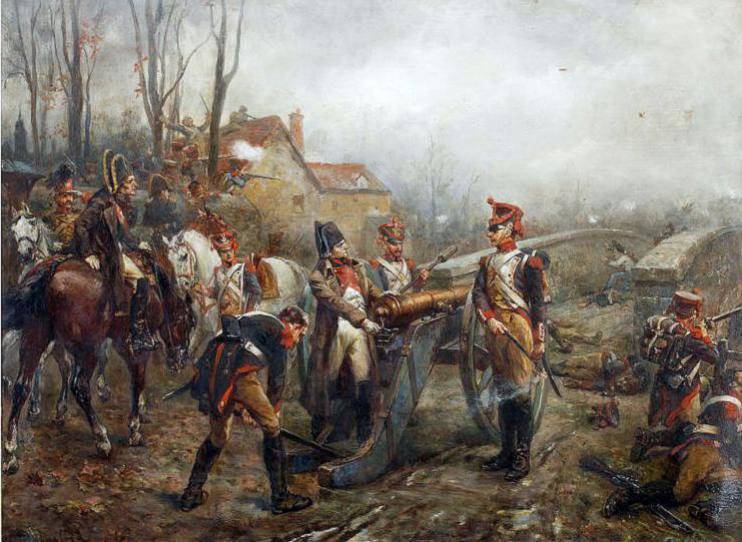
Napoleon in the battle of Montro. English artist Robert Alexander Hillingford.
12 (24) February, the army of Blucher moved through Cézanne and La Ferte-sous-Joir towards Paris to meet the oncoming reinforcements. At this time, Napoleon's army was moving towards Troy. February 23 General Gerard knocked over the Austrian rearguard, capturing 4 guns. The French approached Troyes from several directions. However, they did not immediately go to the assault. Late in the evening, Napoleon ordered the batteries to be placed near the city and opened heavy artillery fire. Then the French stormed the city three times, but were repelled by the troops of the Archduke Rudolph. 24 February, when all the Allied forces retreated to the right side of the Seine, the Austrian rearguard cleared Troy.
Napoleon solemnly entered Troyes. Residents of the city happily greeted him, in contrast to the unfriendly reception of three weeks ago. This joy was caused not so much by devotion to the emperor, as by the oppression of the Austrians who occupied this city. In Troyes, Napoleon decided to turn the army back against Blucher. The pursuit of Schwarzenberg could not lead to a decisive success, since the Austrian commander did not want to join the battle and could continue to retreat. Napoleon ordered Macdonald and Oudinot (about 40 thousand people) to continue the pursuit of the Main Army, and he decided with the other half of the army (up to 35 thousand soldiers) to act against Blucher. He was to be supported by the troops of Mortier and Marmona, previously left in the valley of the Marne.
It must be said that during the retreat the troops of the Main Army learned some of the sad experience of the Great Army of Napoleon, who was retreating from Moscow. Troops retreated as quickly as if they had lost a decisive battle. The troops were tired, weakened by a multitude of lagging soldiers who sought shelter from the cold and food. The morale of the army fell, many believed that the retreat would be completed only beyond the Rhine. In addition, retreated along the same roads, which were moving to Paris. The terrain was devastated and could not supply the army with everything necessary. As a result, the officers lost confidence in the command, and the soldiers of many formations almost turned into a wild horde, which almost completely lost discipline.
On February 25, three monarchs held a military council in Bar-sur-Aux, to which commanders and diplomats were invited. It was decided to negotiate at the Chatillon Congress on behalf of all the Allied powers in order to prevent a separate agreement of France with one of the countries. Militarily, they decided not to engage in a general battle at Bar-sur-Aube. The main army, in the event of the further advance of Napoleon, was to withdraw to Langres and unite with the reserves there, giving battle to the enemy. In addition, the Emperor Alexander and King Frederick William demanded that in the event of Napoleon’s movement against Blucher’s army, the Main Army immediately launched a counterattack. Alexander, to warn further retreat of the Austrians, said that in this case, the Russian troops would leave the Main Army and unite with Blucher. The Prussian king supported the Russian monarch. In addition, it was decided to form the Southern Army. The 1 Austrian corps of Bianki, the 1-I reserve Austrian division and the 6 German corps were to enter it. This army was supposed to go to Macon, push aside Augere's troops, providing the communications of the Main Army from the southern flank and covering the Geneva direction.
February 25-26 troops Schwarzenberg continued to retreat. On August 26, the king of Prussia and Schwarzenberg received a message that Blucher crossed the River Ob and moved against Marmont, and Napoleon was moving towards Marne, leaving only part of his army against the Main Army. Commander of the Allied army's rearguard, Earl Wittgenstein reported that the French pressure had eased, which meant that Napoleon had quit. Wittgenstein offered to immediately launch a counterattack. The Prussian king agreed with his opinion and insisted on the cessation of the retreat and the transition of the advanced corps to offensive action. February 27 on the offensive were to go to the corps of Wrede, Wittgenstein and the Wurttemberg crown prince. They were supposed to reinforce the Russian and Prussian Guards cavalry units. However, they did not have time to arrive at the beginning of the battle.
Battle
February 26, commander of the vanguard of Oudinot, General Gérard approached Bar-sur-Aubret at noon and occupied it, knocking over the Austrian division of Gardegg that was stationed there. General Gerard tried to continue the movement, but was stopped by cross-artillery fire from the Wrede corps batteries.
By the beginning of the battle, the location of the French troops was as follows: the division of the National Guard Pakto was left in Dolancourt; in Bar-sur-Aube there is the division of Duhem; two divisions (Leval and Rotemburg) were put on a plateau north of the city, in order to secure the left flank. In addition, one division was located to link these troops with the units that occupied the city. The cavalry was divided into two groups: the corps of General Kellermann was located north of the city on the plateau at Spoy, and the cavalry of de Saint-Germain at Eleville and Moutier, behind the infantry orders. In all, Oudinot had about 30 thousand soldiers. Apparently, Oudinot did not expect an attack and planned the next day to continue the pursuit of the enemy.
Austrian light division in February 15 (27) battle at Bar-sur-Aube. M. Trenzensky.
Wrede and Wittgenstein received orders the next day to go on the offensive. The troops gladly met this news. Corps Wrende was supposed to attack Bar-sur-Aube. The corps of Wittgenstein was supposed to support the attack of Wrede and strike a blow to the right of the city, near Ileville.
At night, the Bavarians conducted reconnaissance in force. 8-th Bavarian infantry regiment broke into Bar-sur-Au, captured the outpost and tried to pave the way to the center of the settlement, but having met the superior forces of the enemy, retreated. The French were able to cut off the advance units, but they made their way to their own, losing 7 officers and 200 soldiers killed, wounded and captured. The commander of the regiment, Major Massenguzen, also perished. However, the Bavarians held the captured suburb.
In the morning, on the plain in front of the city, Vrede built his troops in two lines. Ahead was the avant-garde, on the left flank - Bavarians, on the right - the Austrian division of Fremont. The flanks supported the Cossacks with part of the regular cavalry. In addition, the Bavarians occupied the Shomon suburb. The frontal attack did not promise decisive success, so they decided to bypass the enemy from Leigny. The 5 th corps of Wrede (20 thsd. People) was to conduct a demonstrative attack while the rest of the troops pass the enemy positions. A roundabout commissioned Wittgenstein’s 6 Corps (16 thousand). He had to advance in the general direction of Arsonval, seize the bridge from Dolancourt, cutting off the enemy's escape route. Part of the Wrede troops was located at Saint-Germain, watching the enemy at Spey.
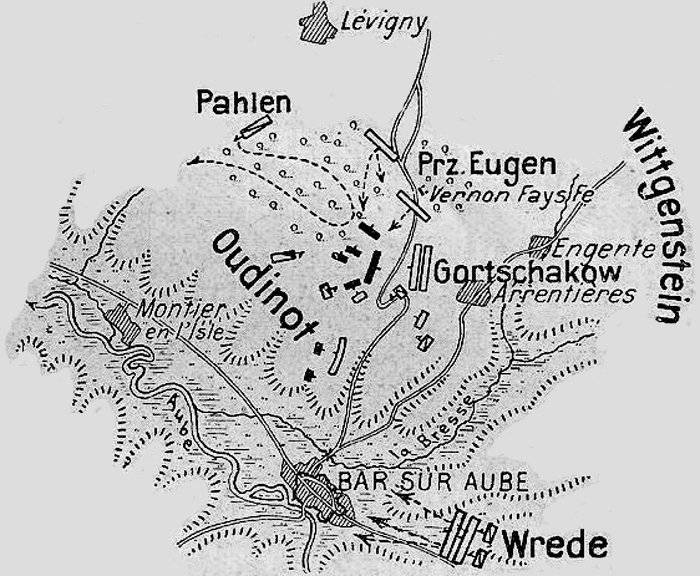
Battle plan
At about 10 in the morning hours, the Bavarian shooters tied up a skirmish in the suburbs. Simultaneously, the corps of Wittgenstein, designed to bypass the left flank of the French position, divided into three columns, moved forward. The first column consisted mainly of cavalry: the Grodno, Sumy, Olviopolsky hussars, the Chuguevsky lancers and the Ilovaisky, Rebrikov and Vlasov Cossack regiments, the 3th Infantry Division. It was headed by Lieutenant-General Count Peter Palen. The column was supposed to move through Arentier and Levigny to Arsonval in order to capture the bridge at Dolancourt.
The second column was made up of units of the 4 Infantry Division. It was headed by Prince Eugene of Württemberg. She was also advancing on Arsonval, towards the Dolancourt Bridge. The column of the Prince of Württemberg performed the task of supporting the connection between the right and left columns. The third column consisted of the 5 and 14 infantry divisions, the Pskov Kirasirsky and Lubensky hussars. The commander was Lieutenant-General, Prince Andrei Gorchakov 2. She had to support the actions of the first columns. In addition, Major General Yegor Vlastov with two Chasseurs regiments was supposed to take positions at the Arentier river, covering the movements of the other troops.
However, the body of Wittgenstein was late with a roundabout maneuver. The French could not be taken by surprise. Oudinot, having detected the movement of the enemy’s columns, immediately built troops into battle formation, occupied the forest with Levigny, and closed the road from Bar-sur-Auba to Ayleville and Arsonval.
Jäger regiments, which were part of the Palen column, engaged the enemy in the forest at Levigny. Prince Württemberg’s column struck up a battle at Vernopfe and, knocking over the enemy with strong artillery fire, captured the manor. At the same time, the huntsman Vlastova joined the battle. The French General Montfort crossed the ravine with the 101 and 105 lines of the Levalle division and overturned the rangers. The Prussian king who was here with his sons restored order to the regiments and sent the Russian rangers to the counterattack.
Fearing that the enemy would be able to divide the Allied corps, Wittgenstein ordered Prince Gorchakov not to move behind the second column, but to attack the enemy’s right wing. Wittgenstein personally led the Pskov Cuirassier Regiment to attack, to support the rangers. But rough terrain and vineyards hindered the effective use of cavalry in this area. During the attack, Wittgenstein was injured. Against the French, 4 guns were advanced; they were able to keep the enemy with a shotgun fire. And the regimental rangers of Vlastov, with a new counterattack, overthrew the enemy over the ravine.
At this time, the Gorchakov column approached. However, before it was built into battle formations and launched an offensive, the French cavalry went on the attack. The French had time to redeploy Kellerman's cavalry corps from Spoy. The French cavalry overturned the Pskov Cuirassier and Lubensky hussars. The French infantry went on the offensive. There was a threat of separation of the corps of Wittgenstein and Wrede, a breakthrough of the enemy to the rear of the allied forces.
Therefore, Wittgenstein decided to completely abandon the workaround and ordered to return first to the column of Württemberg, and then to Palen. While the troops were returning, the French were restrained by the fire of Russian batteries, advantageously supplied by the generals Lowenstern and Kostenetsky. General Ismert with one of the dragoon brigades of the Kellerman Corps tried to seize the guns, but the Russian batteries, letting the enemy through 100 steps, opened fire. With the help of grapeshot, the Russian gunners repulsed several French cavalry attacks. The French lost more than 400 people.
The French division of Leval with the joined Chasset brigade continued to advance. She was supported by the division of Rotemburg and the cavalry of Saint Germain. At this decisive moment, the Kaluga Infantry Regiment struck a flank attack on the enemy. He was followed by Mogilev, Perm and other regiments of Prince Gorchakov, supported by artillery fire. At the same time (around 4 hours of the day) Schwarzenberg ordered Wrede to more actively attack the right wing of the French at Bar-sur-Au, sent to reinforce Wittgenstein a detachment of five infantry battalions and five regiments of cavalry of the Austrian and Bavarian troops. The troops of Gorchakov and Wurttemberg attacked in unison. Count Palen again received orders to move to the Dolankursky bridge.
Udino, noting the strengthening of the enemy and his general offensive, ordered the troops to leave their positions and retreat. At this time, the Bavarians attacked Bar-sur-Aube. Wrede sent 5 battalions to storm the city and sent a detachment of 4 battalions under General Gertling to the right to go around the enemy. General Duhem well prepared the city for defense. He blocked all the streets with barricades, and put batteries behind the city, on the heights. Colonel Theobald with the 10-th Bavarian Linear Regiment broke into the city, but then it stalled. The French arrows occupied the house, the streets were blocked. We had to storm every house. The French fought hard. Only when it became clear that the main forces had departed and, fearing encirclement, Duhem withdrew the division from the city. The bulk of the division retreated along the road to Sing, several battalions in the direction of Ayleville.
Cut off the enemy forces failed. The cavalry of Palen with several guns occupied Arsonval heights only in the evening when the main enemy forces were already behind Both. Udi brought all the artillery. Palen was only able to upset the French rearguard with artillery fire.
Artist Oleg Parhaev.
Results and consequences of the battle
In the battle for Bar-sur-Aube, French troops lost more than 3 thousand people (2,6 thousand killed and wounded, about 500 prisoners). Allies lost 1,9 thousand people (according to other sources - 2,4 thousand people). The main losses fell on the Russian troops, the Bavarians and Austrians lost 650 people. Schwarzenberg was contused. In battle, Count Wittgenstein was wounded. He surrendered command to Rajewski (the corps was handed over to Lambert). Wittgenstein’s departure was no longer associated with injury, but disagreement with Schwarzenberg’s actions and Wrede’s honors. The Bavarian Corps in this battle did not earn much glory, but Wrede was awarded the Order of George of the 2 degree and promoted to field marshal. The King of Prussia, to his credit, testified before Alexander the courage of the Russian troops and the skillful management of them by Wittgenstein.
To develop success Schwarzenberg failed or did not want. He feared the emergence of the main forces of Napoleon. Justified by fatigue of troops who had to move in war-ravaged areas. With the appearance of Napoleon would have to depart reinforced marches. Therefore, for the enemy sent only cavalry, supported by small infantry detachments with guns.
16 (28) February Oudinot joined in Vandevre with the troops of MacDonald, increasing the number of French troops to 35 thousand soldiers. On the same day, parts of the McDonald's corps entered into battle with the units of the Guilaya corps. In the case of La Ferte-sur-Both, the French lost 750 people killed, wounded and captured. Allied forces lost about 600 people. MacDonald was forced to withdraw the troops of the Seine, leaving Troy.
5 March Allied forces once again occupied Troyes, but here Prince Schwarzenberg stopped his advance, following the instructions of the Austrian cabinet not to retire far beyond the Seine. The main battles with the French turned north-west, beyond the river Marne, between Napoleon and the army of Blucher.
F. Kamp. The victory of the combined troops of Prince Schwarzenberg at Bar-sur-Aube
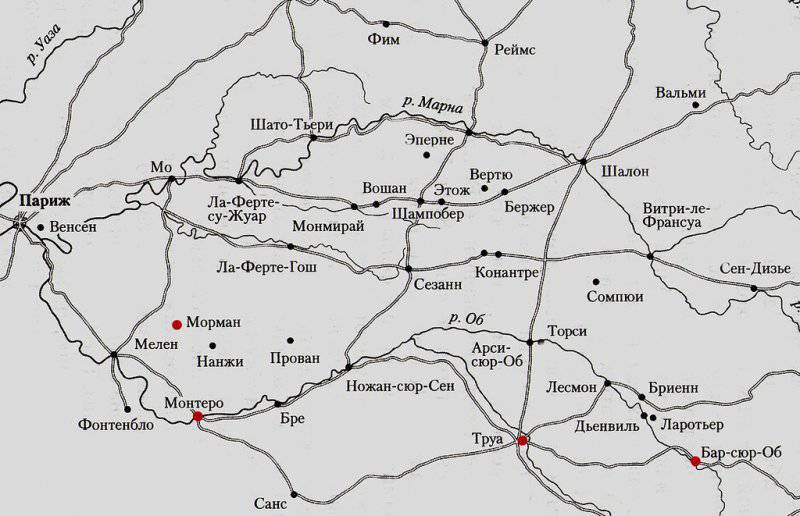
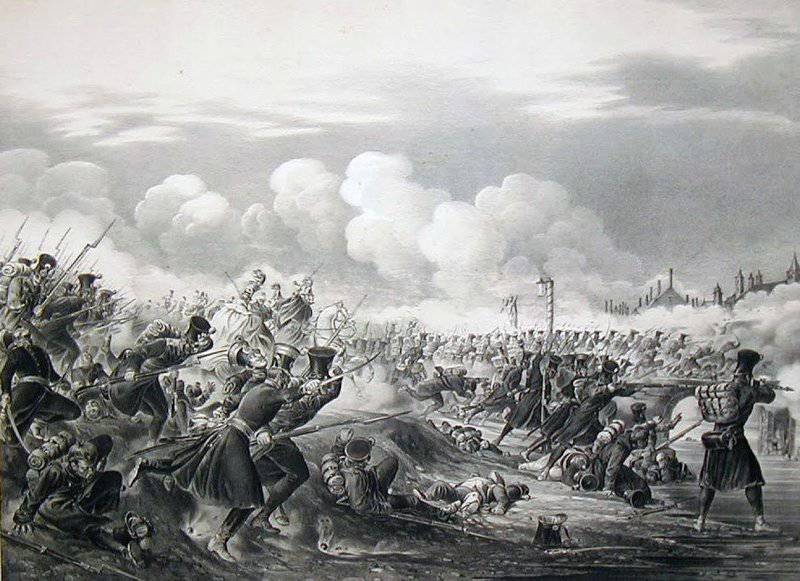
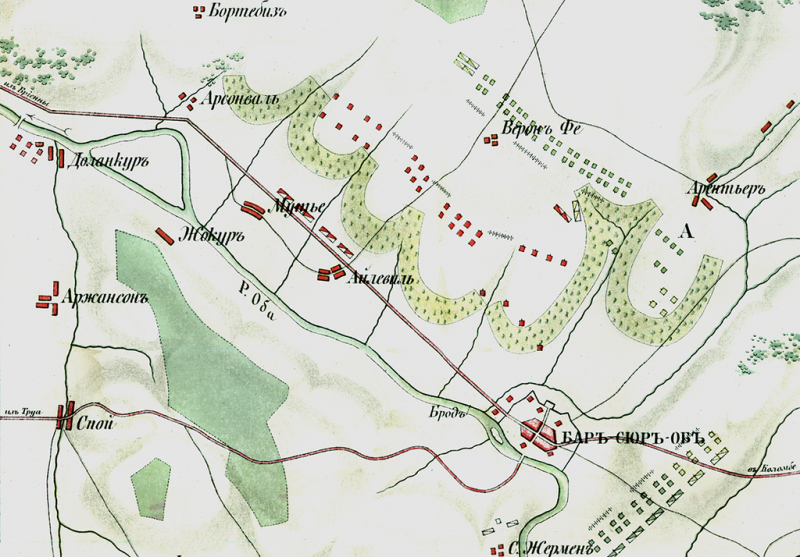
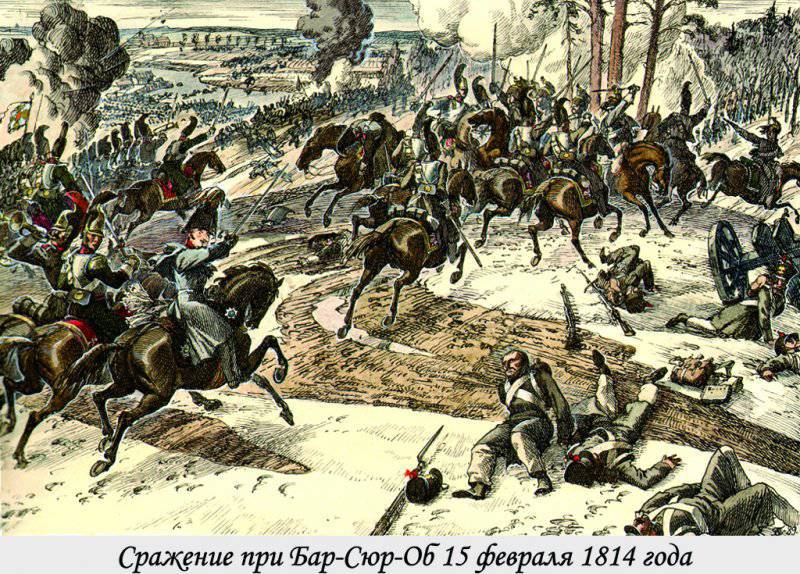
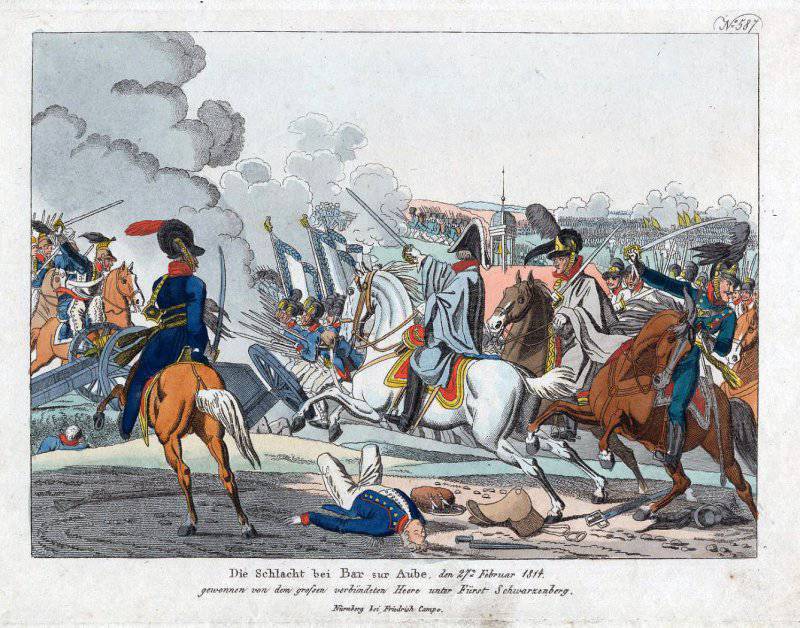
Information